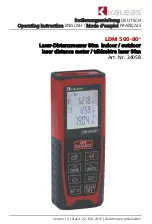
inverse of what comes in through pin 16. The other half of U17B switches the signal into the oscillator
control circuit which causes the oscillator to turn off. This is done when the switch is closed by causing
the signal to unbalance the oscillator control circuit in such a way that no current can flow to the
oscillator. Under that condition, C9 is disconnected from the circuit during the measuring period and the
diode pair, CR1 and CR2, act to clamp the circuit to prevent U14’s output from going more than 1V from
ground independent of the applied signal. U15 is a comparator that detects whether the output of U14,
pin 6, is either positive or negative. The output of U15 then goes to the C port of U9 as an input. This
tells the CPU whether U14’s output is either high or low as determined by the comparator. In the
measurement mode, there is also a CPU driven successive approximation routine which puts a series of
words out to the DAC, U10. Then, using standard successive approximation, the voltage level at TP9 is
determined and placed in memory. On the basis of the voltage placed in memory and knowing the desired
power out, the CPU can then calculate the voltage that must be written to U10 to control the oscillator
for the desired output power. To briefly recap, the process is to measure the bridge voltage with no RF
applied, determine the desired output power, and then write voltage corresponding to that power to the
U10 DAC.
When it is required that the oscillator be controlled, the B7 output of U9 will supply a high voltage
signal to close the switch at C9 and open the switch on CR1 and CR2. C9 then serves to stabilize the
complete control loop while the thermistor bridge system controls the oscillator. The control system
operates in the following way. The oscillator provides RF power to the thermistor and, the more RF
applied, the less dc power is required in the self-balancing bridge. Consequently, as the RF power
increases the voltage at TP9 will decrease. This voltage feeds into the summing junction at U14. Since
diodes CR1 and CR2 are switched out of the loop, the feedback circuit then goes from pin 6 of U14
through R51 to the input of U18D. Pin 11 of U17B is open now, so there is no current fed to U18D from
that point, and the voltage applied through R51 directly controls the current through Q6.
R47, R48, R49, R51, R52, U18D, and Q6 form a voltage to current converter. The voltage over R49 will
equal the input voltage present at R51, but will be shifted to be relative to -15 V (can be read at TP7).
See Figure 4-3, the current through R49 will be Vin/R49. Assuming that Q6 has a current gain much
greater than 1, the current driving the oscillator can be approximated to Vin/R49. As the voltage
increases, the oscillator output power and the RF power dissipated in the thermistor will increase
resulting in a decrease of the bridge voltage at TP9.
The decrease of voltage will reflect as a decrease in the level of current and, finally equilibrium will be
obtained where there is just enough power being supplied to the oscillator to bring the summing junction
to a balance at U14. The oscillator will then regulate at that level. The net result is that whatever is
3.3 K
13 3.3 K
13 .3 K
-15V
13.3 K
13.3K
1 K
U 18D
_
+
Q 6
R
I
V
in
I
ou t
R
I
=
V
in
I
o u t
40.2
Ω
Figure 4-3. Voltage to Current Converter
Series 8500A Peak Power Meters
4-6
Manual No. 20790, Rev C, November 1998
Summary of Contents for 8501A
Page 12: ...Series 8500A Peak Power Meters x Manual No 20790 Rev C November 1998 ...
Page 16: ...Series 8500A Peak Power Meters xiv Manual No 20790 Rev C November 1998 ...
Page 18: ...Series 8500A Peak Power Meters xvi Manual No 20790 Rev C November 1998 ...
Page 74: ...Series 8500A Peak Power Meters 2 48 Manual No 20790 Rev C November 1998 ...
Page 156: ...Series 8500A Peak Power Meters 4 30 Manual No 20790 Rev C November 1998 ...
Page 180: ...Series 8500A Peak Power Meters 5 24 Manual No 20790 Rev C November 1998 ...
Page 230: ...Series 8500A Peak Power Meters 8 2 Manual No 20790 Rev C November 1998 ...
Page 236: ...Series 8500A Peak Power Meters A 6 Manual No 20790 Rev C November 1998 ...
Page 262: ...Series 8500A Peak Power Meters Index 8 Manual No 20790 Rev C November 1998 ...
















































